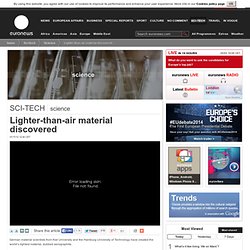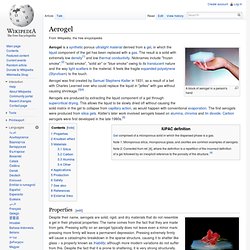

Lighter-than-air material discovered. German material scientists from Kiel University and the Hamburg University of Technology have created the world’s lightest material, dubbed aerographite.

One cubic centimeter of aerographite weighs just 0.2 milligrams, which is four times lighter than the previous record holder, 5,000 times less dense than water, and six times lighter than air. Aerographite is so light that it is difficult to work with it in a normal lab. Any small movement in the lab can create winds that blow the material around. “If you wanted to have one kilogram of this material it would be five cubic metres large. That means a one square metre base, which goes five metres up in the air like a house or tower – that would be one kilogram. Aerographite is a mesh of carbon tubes, each around 15nm in diameter, interwoven at the micro and nano-scale level. The material is created by putting zinc oxide crystals in special ovens and then heating them to 900 degrees Celsius. Aerogel.
A block of aerogel in a person's hand Aerogel was first created by Samuel Stephens Kistler in 1931, as a result of a bet with Charles Learned over who could replace the liquid in "jellies" with gas without causing shrinkage.[3][4] IUPAC definition Gel comprised of a microporous solid in which the dispersed phase is a gas.

Note 1: Microporous silica, microporous glass, and zeolites are common examples of aerogels. Note 2: Corrected from ref. [4], where the definition is a repetition of the incorrect definition of a gel followed by an inexplicit reference to the porosity of the structure. [6] Properties[edit] A flower is on a piece of aerogel which is suspended over a flame from a Bunsen burner. Aerogels are good thermal insulators because they almost nullify two of the three methods of heat transfer (convection, conduction, and radiation). Owing to its hygroscopic nature, aerogel feels dry and acts as a strong desiccant. Knudsen effect[edit] Carbon nanofoam. Carbon nanofoam is an allotrope of carbon discovered in 1997 by Andrei V.

Rode and co-workers at the Australian National University in Canberra.[1] It consists of a cluster-assembly of carbon atoms strung together in a loose three-dimensional web. The material is extremely light, with a density of 2-10 g/m3 (.0012 lb/ft3).[1][2][3] Each cluster is about 6 nanometers wide and consists of about 4000 carbon atoms linked in graphite-like sheets that are given negative curvature by the inclusion of heptagons among the regular hexagonal pattern. This is the opposite of what happens in the case of buckminsterfullerenes, in which carbon sheets are given positive curvature by the inclusion of pentagons.
The large-scale structure of carbon nanofoam is similar to that of an aerogel, but with 1% of the density of previously produced carbon aerogels—or only a few times the density of air at sea level. Notes[edit] References[edit] Cabot Aerogel: Aerogel for Insulation, Daylighting, Additives - Cabot Corporation. Graphene aerogel takes world’s lightest material crown. Not even a year after it claimed the title of the world’s lightest material, aerographite has been knocked off its crown by a new aerogel made from graphene.

Created by a research team from China’s Zhejiang University in the Department of Polymer Science and Engineering lab headed by Professor Gao Chao, the ultra-light aerogel has a density lower than that of helium and just twice that of hydrogen. Although first created in 1931 by American scientist and chemical engineer, Samuel Stephens Kistler, aerogels have recently become a hotly contested area of scientific research. A “multiwalled carbon nanotube (MCNT) aerogel” dubbed “frozen smoke” with a density of 4 mg/cm3 lost its world’s lightest material title in 2011 to a micro-lattice material with a density of 0.9 mg/cm3.
Less than a year later, aerographite claimed the crown with its density of 0.18 mg/cm3. “With no need for templates, its size only depends on that of the container,” said Prof. Breakthrough: This metal is almost as light as air.